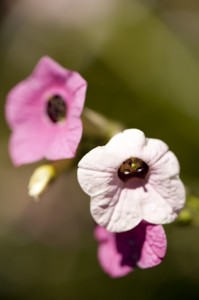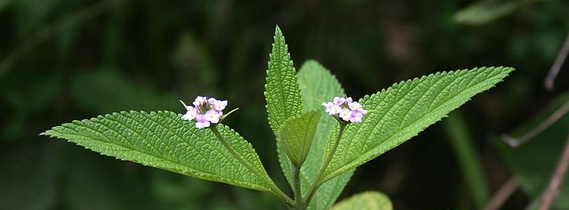An Annual Affair
Posted in Gardening Tips on November 19 2013, by Sonia Uyterhoeven
Sonia Uyterhoeven is the NYBG‘s Gardener for Public Education.

Evaluation is an important process in the garden. It teaches us to understand what grows well in specific sites and what struggles or fails; what combines well and what doesn’t; and it affirms our likes and dislikes between different species and varieties. That said, I always like to take a few minutes to reflect on the season’s best performers so I can add them to the expanding repertoire of stellar annuals for every gardening occasion.
One of my favorite annuals in the garden this year was the flowering tobacco Nicotiana mutabilis. This tender perennial (hardy in zone 8) flowers from June until first frost without slowing down or missing a beat, creating a colorful haze in the garden with dainty trumpet-shaped flowers that smother its wiry, 5-foot-long stems.
The specific epithet mutabilis means “changeable,” and it’s more than appropriate. The flowers on this flowering tobacco open white, morph into a pale pink, and finish dark pink, giving the impression that there are three different flower colors on the plant. The foliage has a tropical feel to it, adding to this gardening belle’s natural mystique. But can it possibly get any better? Of course! Nicotiana mutabilis is deer resistant, attracts hummingbirds, and is easy to seed around the garden.
Adjacent to the flowering tobacco this year was the scented geranium Pelargonium ‘Snowflake’, creating an attractive partnership between the two. The scented geranium is a mounding ground cover that grows 18-24 inches tall. It loves to spread and fill out the front of a border with its soft apple green leaves, irregular white markings, and pale, lavender-pink flowers, complementing Nicotiana mutabilis‘ color scheme beautifully.
Pelargonium ‘Snowflake’ has fragrant foliage with a lemony-rose aroma, one of the more palatable smells among the scented geraniums. My personal favorite is the large, fuzzy, felt-leaved peppermint geranium (Pelargonium tomentosum) with its mouthwatering scent. However, in a contest for aesthetics, ‘Snowflake’ has the edge with its white markings and better flowering stamina.

Since I am clearly in the mood for pastel shades, I should also add one of my favorite lantanas to the mix, Lantana trifolia. This three-leaved lantana is a tropical plant that is hardy in zone 9. Unlike Lantana camara, the traditional, marvelously mounding lantana found in the nursery trade, Lantana trifolia is an upright grower that can easily reach 3 feet tall.
This lantana has beautiful lavender flower clusters that cover the plant all season long. Once the flowers senesce, the flower spike elongates and produces lavender fruit. Butterflies love to feast on this species, deer avoid it, and it is a champion when it comes to handling the heat and drier weather in summer. But for those with small children and curious pets, be aware: all parts of this plant are poisonous.
While we’re at it, I’ll toss one more player onto the ever growing list of solid performers: Gomphrena globosa ‘Light Pink’. I admit this was a variety that I initially had mixed feelings about, despite being a big fan of globe amaranth in general; they always add something special to garden design with their charming, globe-shaped flowers and incredibly floriferous habit. They make splendid displays when cut or dried, and cover all the bases for a solid annual by being deer resistant, drought tolerant, easy to grow from seed, and attractive to butterflies.
These qualities hold true for ‘Light Pink’, as well, but my initial misgiving was due to the variety’s demure color. In contrast to the fiery Gomphrena globosa ‘Strawberry Fields’ and the explosive Gomphrena ‘Fireworks’, it paled in comparison. And worse, the Zinnia elegans ‘White Wedding’ surrounding the plant earlier in the season left a lack of contrast in the bed, allowing the small, globe-shaped flowers of the amaranth to fade into obscurity beneath the shadow of the large white zinnia.
Later in the season the zinnia was pulled out and replaced by a beautiful blue-leaved kale called ‘Winterbor’. The globe amaranth immediately popped with its new partner in place. At the same time, the Mexican sage Salvia leucantha began to flower, and the cuddly purple pipe-cleaner flowers of the sage brought out the pink hue in the globe amaranth, creating a stunning contrast among these new companions. But maybe you have some ideas of your own on how to make your garden beds pop—write in and tell me about your favorite annuals or combinations from the past year.
Lantana trifolia image courtesy of Wikimedia Commons.


A spectactularly good column — talking about plants I love, including scented geraniums and Mexican sage.